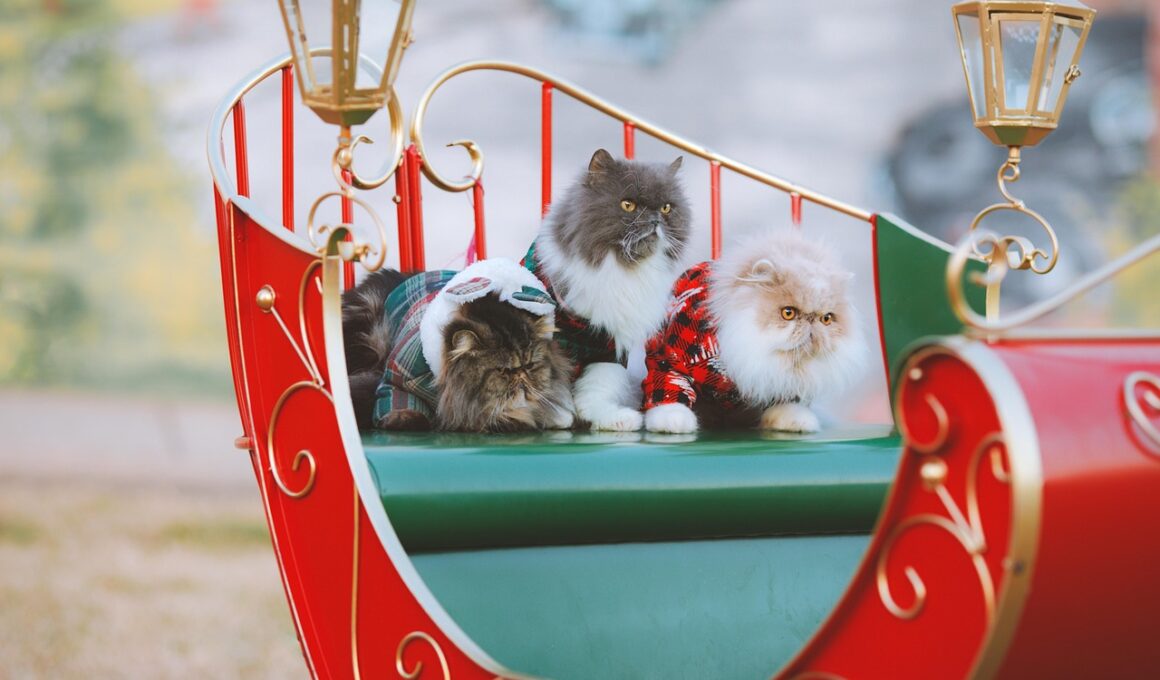Seasonal Changes and Their Effect on Cat Play Behavior
Understanding your cat’s play behavior is essential for providing the best environment for them. Seasonal changes can greatly affect how cats engage in play, influencing their overall mood and activity levels. As seasons shift, the daylight hours change, impacting your cat’s internal clock. During longer daylight hours in spring and summer, cats may become more active and playful. Conversely, the shorter days of fall and winter can lead to increased lounging and decreased playtime. Factors such as temperature and weather conditions also play a major role. Cats may prefer to chase after toys when it’s warmer outside. They become more energetic and seek out playtime, often finding entertainment in engaging with owners or other pets. In colder months, a cat’s hunting instincts may drive them to search actively despite the chill. Their play styles may alter too, favoring indoor toys over outdoor activity. Understanding these changes allows owners to adjust play strategies accordingly, ensuring the cat remains stimulated throughout the year. Observing these behaviors can inform your approach, allowing for a happier and healthier feline companion.
Seasonal transitions bring different moods to our feline friends. As the weather cools down, your cat may retreat to warmer spots, preferring gentle interactions. This preference for coziness sometimes leads to less vigorous play. In contrast, spring can trigger exuberance, which encourages vigorous sessions of play. Cats may feel revitalized by fresh scents of the outdoors and visible wildlife outside their windows. It becomes essential to recognize the signs of your cat’s preference during these transitions. Owners can enhance playtime by introducing seasonal toys, like feather wands in spring or cozy cat tunnels in winter. Knowing the cues from your cat helps in engaging their attention in meaningful ways. Interactions should revolve around their moods influenced by the seasonal atmosphere. By observing your cat’s reactions to varying types of play, you’ll discover their favorites. Try setting up play schedules that align with these instinctive patterns, such as active times in the afternoons during sunny days. Understanding weather influences can reinforce the bond between you and your cat, contributing to your cat’s fulfillment and happiness all year round.
Impact of Seasonal Activities on Play Preferences
Each season comes with unique opportunities for play. Summer is often filled with outdoor adventures, with many cats loving to explore their surroundings. The sunshine provides the perfect backdrop for more spontaneous play, often resulting in very much loved sessions. Managing such activity is crucial, as it helps to prevent boredom and maintains a strong mental state. Cats often enjoy various outdoor games, such as hide and seek, or simply chasing after lightweight toys. Seasonal changes offer creative outlets for owners to curate stimulating environments aligned with their cat’s preferences. As nights grow longer in autumn, many cats may start to prefer indoor play, seeking warmth alongside their humans. Indoor activities like puzzle toys and interactive games help accommodate this shift. Witnessing your cat discovering new favorite games can enhance the enjoyment both for the owner and the pet. Winter’s chill may prompt more interactive play sessions; consider a laser pointer or feather toys to stimulate their hunting instincts within the comfort of your home. Understanding the relationship of food, environment, and companionship is essential to nurturing a flourishing play style.
As play styles shift with the seasons, so too does the engagement level of cats with their toys. Understanding their preferences allows owners to tailor their interactions. In winter months, for example, your cat may favor toys that offer warmth or scents reminiscent of their outdoor hunting grounds. Conversely, during the fresh blooms of spring, toys that mimic the movements of butterflies or birds can spark their adventurous instincts. Experimentation is key; varying the types of toys can provide insights into what captivates them at differing times of the year. Indoor challenges such as treat-dispensing toys become especially rewarding in winter. Watching how your feline friend interacts with a rotating selection of toys enhances playtime, deepening the connection between cat and owner. From springtime chase to winter cuddles, the energy of seasonal changes can spark excitement. It’s also beneficial to schedule regular playtime sessions, adjusting them with any noticeable changes in moods or eagerness. Keeping an eye on your cat’s behavior will aid in planning your days, keeping them active and engaged regardless of the season, maximizing both their activity and overall wellbeing.
Environmental Influences on Cat Play
Environmental factors play a significant role in shaping cat behavior and preferences in play. Seasonal changes can invoke shifts in different stimuli that influence their decision to engage in playful activities. For instance, outdoor plants and changes in daylight expand the sensory experiences available to your cat. As birds begin to return during spring, your indoor tabby may become more fixated on aerial antics and engage with home alternatives. Likewise, indoor settings help create enriching spaces for stimulation, regardless of the events outside. Creating environments with diverse textures, scents, or obstacles can mimic outdoor experiences for indoor cats. Climbers, scratchers, and cozy hiding spots create stimulation conducive to play. Elevating indoor entertainment for optimal learning enhances not just playful engagement but also mental and physical health. For seasonal insights, consider rotating toys and settings, which can reinvigorate interest levels. Observations about how your feline interacts with new items versus old favorites can also provide deep insights into their mood shifts as seasons change. Providing regular updates to play zones supports continuous growth and activity while respecting their unique seasonal rhythms.
During different seasons, cats often adapt their hunting methods. Recognizing how this affects play preferences requires attentiveness and creativity. For instance, in warmer weather, a cat may showcase increased energy and eagerness to track movements. During these months, engaging them with toys that activate their hunting instincts is vital. This could involve interactive feather toys or those mimicking prey-like movements. As fall sets in, however, cats tend to switch to a more problem-solving approach to entertain themselves indoors. Introducing food puzzles or automated toys triggers their natural curiosity, benefiting their mental states. Regardless of the season, providing varied entertainment is crucial to ensure they receive adequate exercise and stimulation. Keeping your feline physically challenged reduces the likelihood of boredom-related behavioral issues. Furthermore, creating opportunities for your cat to exhibit their unique play preferences builds a stronger connection between you both. The seasonal shift shapes their desires and interests, so alternating between various toys and activities maintains momentum in their play style, providing tolerance and adaptability for coping with inevitable seasonal shifts.
Conclusion: Adapting to Your Cat’s Seasonal Play Needs
Ultimately, the interaction between seasonal changes and cat play styles greatly impacts overall cat behavior and happiness. By understanding their preferences and adapting to these seasonal play needs, owners can enhance their relationships with their feline companions. Observing behavior patterns enables owners to provide appropriate enrichment, ensuring a healthy balance in the lifestyle of their pets. Seasonal transitions may call for changed toys and different play approaches tailored to moments that ignite their interest. Regular play sessions foster feelings of comfort and attachment, solidifying a strong bond between you and your cat. Keep rotating their play environment, introducing seasonal themes, and personalized interactions to keep their spirits high. Outdoor activities can also encourage healthy exercise and mental stimulation during sunnier seasons. Likewise, engaging indoor games offer exciting alternatives during colder months. By embracing the natural flow of seasons, we can create enriching experiences for our cats that acknowledge their preferences. Ultimately, nurturing a dynamic play schedule throughout the year makes a significant difference in maximizing your cat’s overall enjoyment and fulfillment as a cherished member of your family.
This article has explored the interplay between seasonal changes and cat play preferences. As environments shift, understanding the subtleties of feline behavior can transform your approach to their playtime. Each season brings unique opportunities that require creativity and attentiveness to the individual personality of your cat. The art of adapting your cat’s surroundings while introducing seasonal activities helps in maximizing play engagement. Implementing thoughtful changes based on these shifts genuinely enhances your cat’s daily life while establishing a rewarding relationship. Your observations can lead to improved playtime experiences and happiness. Keep in mind that the understanding of seasonal behaviors is not static; learning about your cat is a continuous journey. Providing options suited to your cat’s changing tastes not only promotes health but also strengthens your bond. By thoughtfully approaching the transitions in seasons through play, you can boost your cat’s enjoyment and mental stimulation. Through empowered playtime, your cat flourishes into a joyous and vibrant companion. Engage actively with their play behaviors, affirming their individuality throughout the shifts of the year. Together with their human companions, cats thrive during every change of season.


